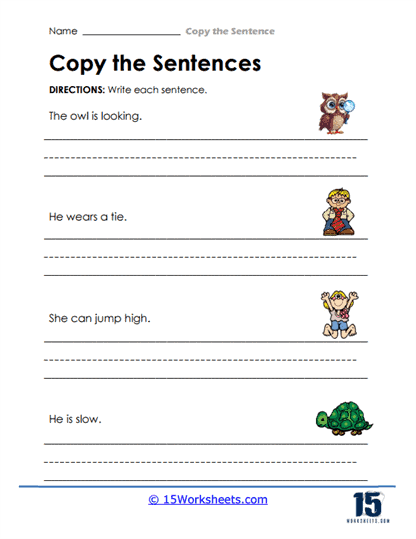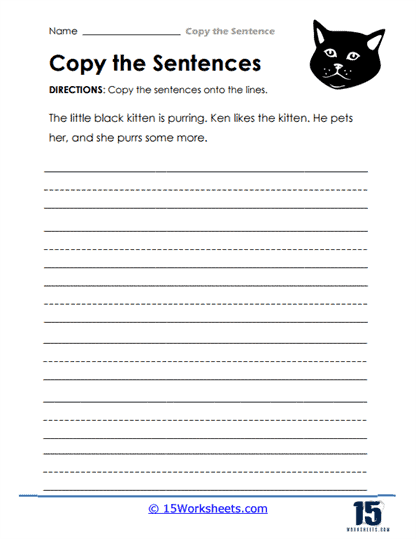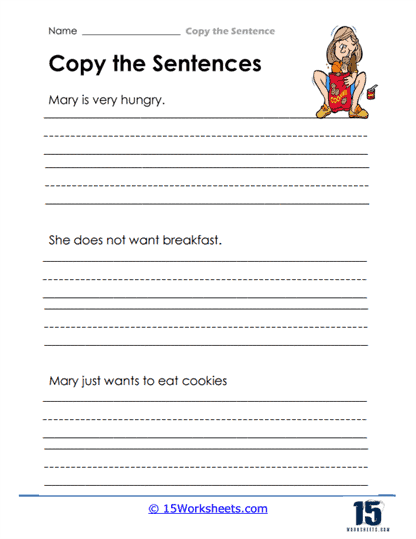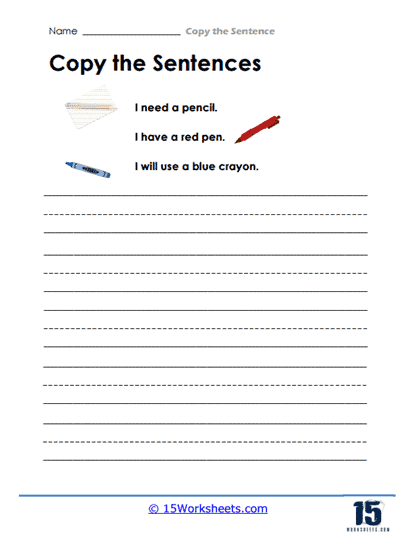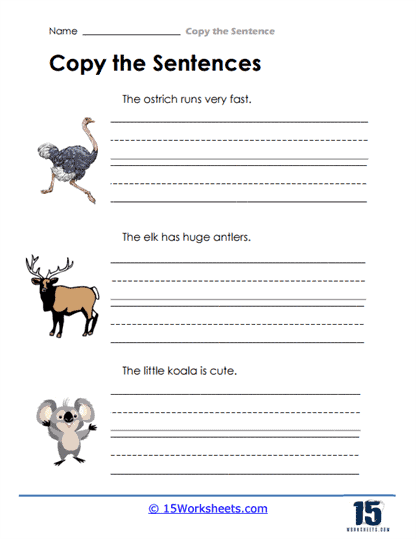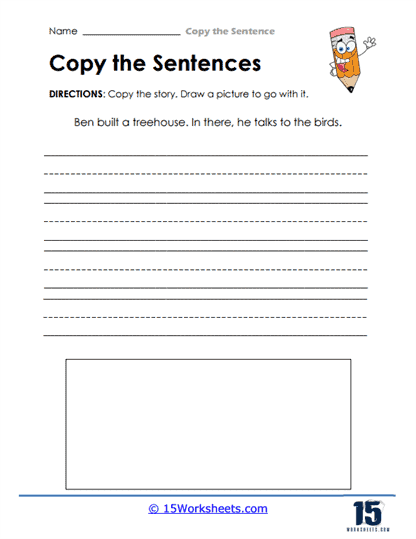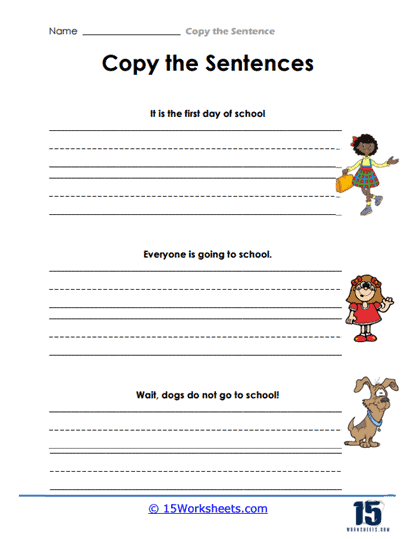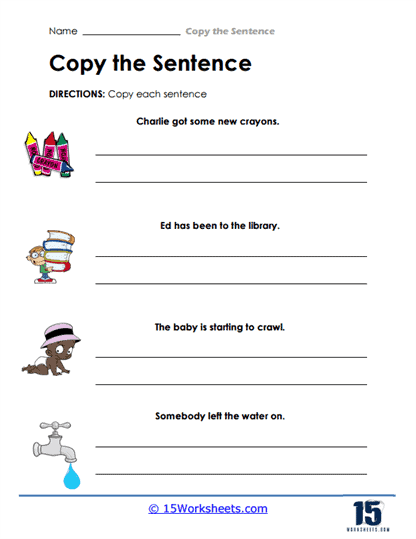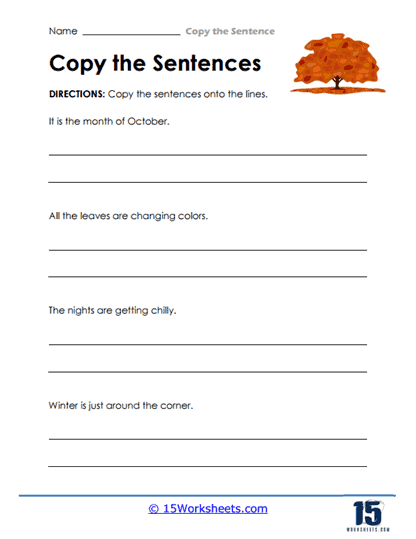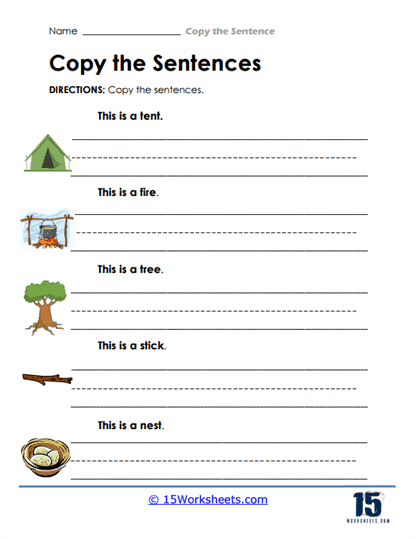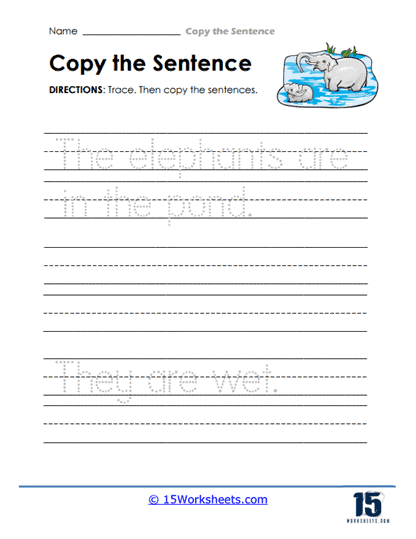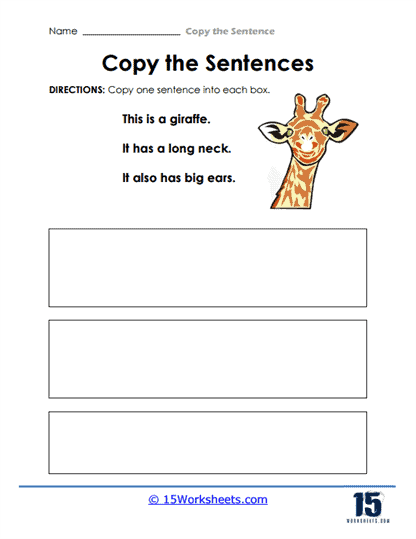Copy the Sentence Worksheets
About These 15 Worksheets
Sentence imitation or replication worksheets, as they are sometimes called, serve as a powerful tool in language education, offering far more than just a simple copying exercise. These worksheets are carefully crafted to strengthen a student’s writing, grammar, and comprehension abilities through the strategic imitation of well-constructed sentences. Though they may seem straightforward on the surface, they possess an inherent versatility that makes them suitable for learners of varying levels, from beginners who need to master the basics of sentence structure to advanced students who are fine-tuning their grasp of complex grammar and vocabulary.
At their core, these exercises are designed to provide students with a clear, structured example of good writing. By engaging in the practice of sentence imitation, students aren’t just copying words—they are internalizing the rhythm, flow, and logical sequence of language. This immersion helps them develop a stronger sense of how sentences function in real communication. Much like how young musicians learn by playing classical pieces before composing their own music, students improve their writing by mimicking the best examples available. Each time they replicate a sentence, they unconsciously absorb nuances of grammar, punctuation, and style, gaining insight into the writer’s craft.
The beauty of these worksheets lies in their adaptability. For younger students or beginners, the sentences may focus on simple, declarative statements that emphasize basic grammar concepts such as subject-verb agreement, punctuation, or capitalization. At this level, the repetition of correct sentence forms is key. As learners progress, the worksheets can gradually introduce more sophisticated structures, including compound and complex sentences, conditional phrases, and varied vocabulary. This progression allows for a scaffolded learning experience, where students build on their previous knowledge without feeling overwhelmed.
In classrooms where sentence imitation exercises are incorporated regularly, teachers often see a noticeable improvement not just in technical writing skills, but in overall communication abilities. Writing is an essential form of expression, and mastering the rules of grammar, syntax, and vocabulary through these exercises empowers students to express themselves more clearly and confidently. As students begin to apply the lessons learned from these exercises to their own writing, their sentences become more fluid, their grammar more precise, and their ideas more coherent.
These worksheets contribute to the development of reading comprehension. When students are asked to imitate or replicate a sentence, they must first fully understand its meaning. This demands careful reading and attention to detail. As a result, students hone their reading comprehension skills, learning to dissect the structure and intent behind each sentence. The act of imitation, therefore, reinforces both the mechanical and interpretive aspects of language.
Sentence imitation exercises also tap into cognitive processes related to problem-solving and creativity. While it may seem counterintuitive, the act of replicating a sentence requires students to think critically about why a sentence works the way it does. By analyzing the elements of a well-formed sentence, they are encouraged to think about how language functions—how words are ordered to create meaning and how punctuation guides the reader through a text. This process builds not only linguistic understanding but also fosters a deeper appreciation for the artistry of writing.
Types of Exercises
Basic Sentence Copying – This is the most straightforward type where students are required to copy sentences exactly as they are written. These sentences typically focus on basic sentence structure, common vocabulary, and fundamental grammar. Sentences may vary in complexity depending on the grade level, ranging from simple to more complex structures. This improves handwriting, reinforces sentence structure, and familiarizes students with punctuation and capitalization.
Punctuation and Capitalization Practice – Here, sentences are provided without proper punctuation or capitalization, and students must rewrite them correctly. This exercise enhances their understanding of grammatical rules.
Paraphrasing Exercises – Students are asked to rewrite the sentences in their own words while maintaining the original meaning. This helps in developing vocabulary and understanding sentence structure. Students first copy a sentence and then rewrite it in their own words. Develops comprehension skills and encourages creative thinking in rephrasing content.
Grammar and Vocabulary Enrichment – Certain worksheets concentrate on specific grammar points, like verb tenses, subject-verb agreement, or the use of prepositions. Students copy sentences while paying special attention to these elements. These worksheets focus on introducing new vocabulary within sentences. Students learn the context and usage of new words while copying them. These exercises include sentences that emphasize specific grammatical elements, such as verb tenses, noun-verb agreement, or the use of adjectives and adverbs.
Complex Structure Imitation – For advanced learners, sentences with complex structures, such as compound or complex sentences, are used. Copying these helps students understand advanced grammar and varied sentence construction.
Error Identification and Correction – Sentences containing deliberate grammatical or spelling errors are given for students to identify and correct before copying.
The Benefits of Practicing with These Worksheets
Improvement in Writing Skills – Regular practice with these worksheets helps in enhancing overall writing skills, including sentence construction, coherence, and style. It also teaches proper formatting, like leaving appropriate spaces between words and understanding margins.
Enhanced Grammar and Syntax Skills – By copying sentences with varied grammatical structures, students unconsciously absorb correct grammar usage, helping them avoid common mistakes in their writing. It helps in understanding complex syntactical constructions, especially in advanced grades.
Vocabulary Expansion – These exercises introduce students to new words and phrases, expanding their vocabulary and enabling them to express themselves more precisely. Exposure to new words in different contexts broadens students’ vocabulary and improves their understanding of word usage. It aids in word retention as the act of writing helps in memorizing new terms.
Attention to Detail – Correcting errors or modifying sentence structures requires careful reading and attention to detail. It cultivates a meticulous approach to writing, which is crucial in academic and professional settings.


